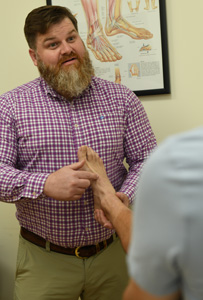Chronic Lateral Ankle Pain
![]() Recurring or persistent (chronic) pain on the outer (lateral) side of the ankle often develops after an injury such as a sprained ankle. However, several other conditions may also cause chronic ankle pain. It is also known as chronic lateral ankle instability, which is characterized by a recurring “giving away” of the outside of the ankle. The fellowship-trained foot and ankle surgeons at Celebration Orthopaedics specialize in the treatment of ankle pain and will diagnose your specific condition to determine the best treatment options.
Recurring or persistent (chronic) pain on the outer (lateral) side of the ankle often develops after an injury such as a sprained ankle. However, several other conditions may also cause chronic ankle pain. It is also known as chronic lateral ankle instability, which is characterized by a recurring “giving away” of the outside of the ankle. The fellowship-trained foot and ankle surgeons at Celebration Orthopaedics specialize in the treatment of ankle pain and will diagnose your specific condition to determine the best treatment options.
Symptoms
With chronic lateral ankle instability, there will be a repeated turning of the ankle, especially on uneven surfaces, as well as continued discomfort and swelling in the ankle. Pain, tenderness, and swelling will also be felt along the affected site.
If your ankle feels unstable and gives way repeatedly, or you have experienced repeated ankle sprains, your condition should be evaluated and treated. Chronic ankle pain, if left untreated, can lead to instability, activity limitations, arthritis, and tendon problems.
Symptoms of chronic ankle instability can include:
- Pain, usually on the outer side of the ankle
- Difficulty walking on uneven ground or in high heels
- A feeling of giving way (instability)
- Swelling
- Stiffness
- Tenderness
- Repeated ankle sprains
Causes
The most common cause of this condition is incomplete healing after an ankle sprain. When you sprain your ankle, the connecting ligament between the bones is stretched or torn. Without thorough and complete rehabilitation, the ligament or surrounding muscles may remain weak and result in recurrent instability. As a result, you may experience additional ankle injuries.
Other causes of chronic ankle pain include:
- An injury to the nerves that pass through the ankle
- A torn or inflamed tendon
- Arthritis of the ankle joint
- A break or fracture in one of the bones that make up the ankle joint
- An inflammation of the joint lining (synovium)
- The development of scar tissue in the ankle after a sprain
Treatment Options
Treatment will depend on the final diagnosis and will be personalized to your individual needs. Both conservative (non-operative) and surgical treatment methods may be used. Conservative treatments at Celebration Orthopaedics may include:
- Anti-inflammatory medications, such as aspirin or ibuprofen, to reduce swelling
- Physical therapy is directed at strengthening the muscles, restoring range of motion, and increasing your perception of joint position
- An ankle brace or other orthotic support
- An injection of a steroid medication
- In the case of a fracture, immobilization is required to allow the bone to heal
If your condition requires it, or if conservative treatment doesn't bring relief, your Celebration Orthopaedics physician may recommend surgery. Many surgical procedures can be done on an outpatient basis. Some procedures use arthroscopic techniques, while others require open surgery. Surgical treatment options may include removing (excising) loose fragments; cleaning (debriding) the joint or joint surface, and repairing or reconstructing the ligaments or transferring tendons.
Recovery
The length of the recovery period will vary depending on the procedure or procedures performed. That’s why it is vital to see your physician at the first sign that something may be wrong. Physical therapy is an important part of recovery.
Prevention of future injuries and sprains is key in preventing chronic ankle pain. Follow your doctor’s instructions carefully regarding medication and rehabilitation. Do not return to activity until cleared by your physician.
